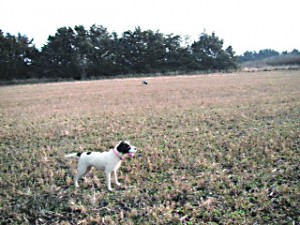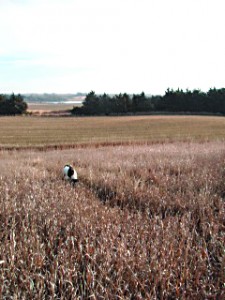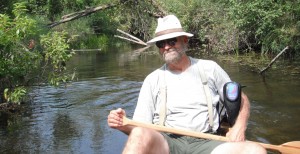I’m an outdoorsman in general. A hiker, camper, canoeist, and birdwatcher. A cross country skier. An amateur botanist of sorts. But mostly, I’m a fisherman and a bird hunter. And I’m also an advocate for land preservation.
My fishing season is long and I travel some long distances, so there is plenty of budgetary evidence how important that is. But it’s a perspective on the bird hunting that our annual expense for winter song bird feed is many major multiples of what I spend on shotgun shells.

Toby
While I may not be that lethal, I’m serious about bird hunting, I travel long distances each year, and spend considerable time at it. It’s something I’ve done most of my life, something I hope I can always do, and something that I hope others who discover the joy of a close working partnership with a bird dog can always do. My dogs are spaniels and they are year around buddies, so I don’t count the dog food under hunting. Don’t tell them though, since in a pheasant field it’s clear they aren’t operating as “pets.” They’re bird dogs. Boy are they bird dogs.
I explain this because it explains why I’m also an advocate for land preservation. Right, you need land to hike and canoe and birdwatch, and land to cross country ski, and land to botanize and to fish. But here in Michigan half the state is available to me for those outdoor times. But here in Michigan, in the fifty years I’ve hunted pheasants, what I’ve seen is less and less land available to hunt.

Tucker
Every old hunting buddy has had the same experience. What used to be a good field for rousting out a few birds is now a subdivision and you and your dogs and your shotgun are going to have to go somewhere else. Then somewhere else is a square mile of corn stubble and the few crows using it look poorly. That’s happened in the Vestaburg area where I started tagging along behind my dad, and in the Saginaw Valley where I first actually hunted. That’s happened around Mt. Pleasant where I first went away to college, and it’s happened around Ann Arbor where I finished college and grad school. And it’s happened around here in Grass Lake and the Waterloo Recreation Area where Charity, (my wife) and I have lived the last forty five years. What are we doing to our farmland that the masses of gorgeous birds we used to have, have disappeared? For that matter, what are we doing to our farmland that it is disappearing?
It’s not just the birds we are losing. Vestaburg, where I started out, was still deep rural countryside. Farmland. Rolling, lovely farmland with woodlots and hedges and widely mixed crops. The farm I wandered as a little tiny kid (with the family spaniel who was supposed to keep me out of trouble I suppose – hah!) is still a farm. And that’s the kind of land pheasants need. They are most successful on well managed and diverse farmland; crops, drains and ditches, brushy edges, woodlots, and some land left fallow. Beautiful, fruitful, productive land. Multi-purpose, multi-use, and absolutely necessary land. Not just necessary for pheasants, completely necessary for people, if we want to eat.

Bill Steere on Portage Creek
And the beauty of that farmland is absolutely necessary if we want to continue to understand who, as people, we all are. Whether we know it or not, we are of the land. All of us are of the land. And we will not be, can’t be, and won’t be, without it.
You bet I’m for land preservation. You bet I’m behind Legacy here in southeast Michigan, and you bet I’m behind national efforts like Nature Conservancy and yes, resource focused hunting groups like Pheasants Forever. They’re in our will. Whatever’s left after the dog food and the bird seed anyway.

 RSS Feed
RSS Feed
Well said Bill.